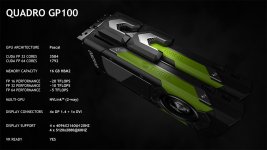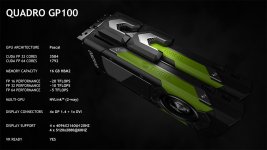Caporegime
- Joined
- 18 Oct 2002
- Posts
- 33,188
Based on the colour of a nvlink connector, wtf?
Even if it can run fp32 code on the fp64 cores... it would almost instantly run into massive throttling trying to use all the cores at the same time(most likely), which is why it doesn't list FP32 performance at 15 or 20flops, ie the FP32 cores + either 1 or if ultra clever, 2 FP32 instructions bundled up on each FP64 core.
It has less FP32 shaders than available on a GP102 card, NVlink likely takes up a fair amount of power, any off die connection takes power, IO and die space which takes away from actual performance. Gaming doesn't require the bandwidth available on NVlink so would be nothing short of a waste of power and cause more throttling than a basic normal sli link.
There is no reason to believe they'll release GP100 as a gaming card ever, if they felt it was a good option... they wouldn't have spent several tens of millions making the GP102 core if they could just make GP100 for both uses.
NVlink has no practical gaming purposes, the bandwidth available on Nvlink is not designed for gaming loads and only adds cost, power usage and uses up transistors for no benefit.
Could you get decent gaming performance from the same shader count as Titan X, sure, if the drivers work well enough and/or you can install normal drivers for it. But it won't be really any better performance than Titan X, but from a core that costs 20-25% more to make. Gamers should have no interest in it, same gaming performance from Titan X, Nvidia should have no interest in selling it as a Titan, it costs more to make so either they make less profit at the same price, or they charge 25% more for the same margin for a card with the same performance.
Even if it can run fp32 code on the fp64 cores... it would almost instantly run into massive throttling trying to use all the cores at the same time(most likely), which is why it doesn't list FP32 performance at 15 or 20flops, ie the FP32 cores + either 1 or if ultra clever, 2 FP32 instructions bundled up on each FP64 core.
It has less FP32 shaders than available on a GP102 card, NVlink likely takes up a fair amount of power, any off die connection takes power, IO and die space which takes away from actual performance. Gaming doesn't require the bandwidth available on NVlink so would be nothing short of a waste of power and cause more throttling than a basic normal sli link.
There is no reason to believe they'll release GP100 as a gaming card ever, if they felt it was a good option... they wouldn't have spent several tens of millions making the GP102 core if they could just make GP100 for both uses.
NVlink has no practical gaming purposes, the bandwidth available on Nvlink is not designed for gaming loads and only adds cost, power usage and uses up transistors for no benefit.
Could you get decent gaming performance from the same shader count as Titan X, sure, if the drivers work well enough and/or you can install normal drivers for it. But it won't be really any better performance than Titan X, but from a core that costs 20-25% more to make. Gamers should have no interest in it, same gaming performance from Titan X, Nvidia should have no interest in selling it as a Titan, it costs more to make so either they make less profit at the same price, or they charge 25% more for the same margin for a card with the same performance.





